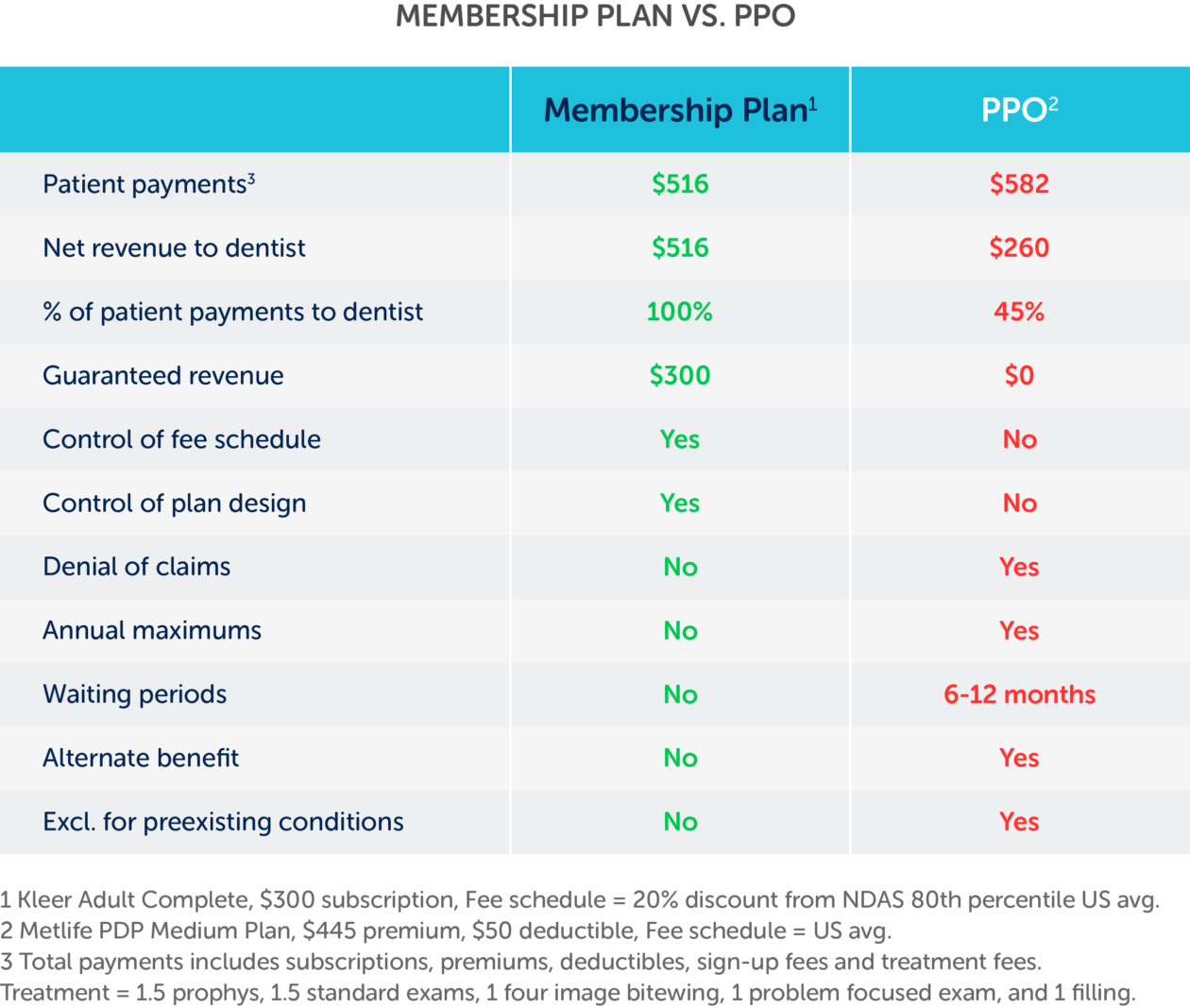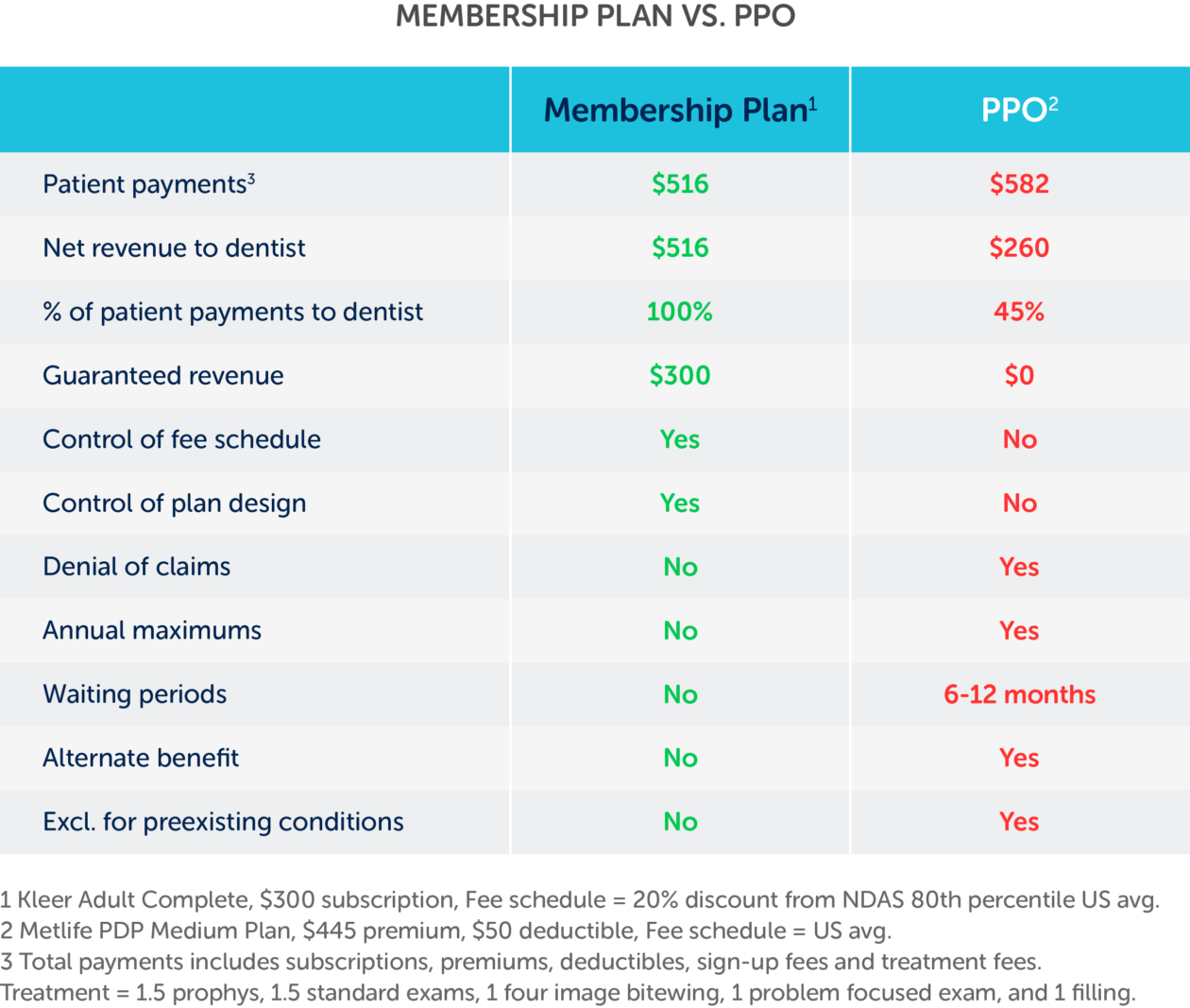Dave Monahan, CEO of Kleer
In the wake of the COVID-19 crisis, dentists are navigating unchartered waters. The cost of doing business has climbed due to requirements for PPE and infection control while production has declined due to patient distancing and a drastic increase in the uninsured patient rate. To make matters worse, these challenges have made the PPO high volume/low reimbursement model obsolete.
While the outlook may appear bleak to some, there is an extraordinary opportunity for forward-thinking dental professionals to use the current climate to shift toward a direct care model that provides patients with better access to care, improves practice cash flow and profitability, and eliminates the hassles and costs of insurance.
Across the dental industry, there is a growing urgency to offer budget-friendly dental membership plans that enable uninsured patients to get the care they need while generating more revenue and cash flow for your practice. This article dives into four challenges brought on by the COVID crisis that make dental membership plans a must-have. We also review key best practices for implementing a successful membership plan at your practice.
Challenge #1: 50 percent of patients do not have dental coverage
As of the start of the summer, U.S. jobless claims due to the COVID-19 crisis hit a record 44 million. Loss of jobs, salaries and employer-sponsored dental benefits significantly reduced the number of insured dental patients. Prior to the crisis, one in three U.S. adults and two in three seniors lacked dental coverage. Because of COVID-related losses of jobs and employer-sponsored dental benefits, we estimate more than 50 percent of adult patients are uninsured.
Patients losing dental benefits will create a substantial risk to your practice’s production. Statistics show that uninsured patients visit the dentist three times less often and accept less than half the treatment of insured patients. Uninsured patients value oral health, however fears about cost and not having coverage keep them from your practice. Job losses and financial insecurity caused by COVID-19 will only reinforce these underlying issues.

The good news is that uninsured patients want coverage. In fact, as part of market research Kleer conducted, 89 percent of uninsured patients surveyed said they were interested in purchasing a dental plan if it is simple, affordable and transparent. Better yet, almost 50 percent said they are very or extremely interested in purchasing a care plan.
A dental membership plan will give patients exactly what they want. Payments are affordable, prices are transparent, coverage is easy to understand, and there are no hassles like deductibles, pre-approvals and annual maximums. Plus, patient benefits start the minute they join.
By making it easier for patients to commit to the care they need, dentists create a “membership club effect.” The subscription-based direct care model brings patients closer to their practice and builds a trusting relationship. Membership plan patients feel good about taking a step toward better oral health, feel financially savvy, and trust their dental practice more due to the simplicity and transparency provided in the plan.
We offer a service to analyze the practice management data of any practice on the Kleer platform. What we see is pretty amazing. Kleer membership plan patients commit to their oral care and purchase two times more treatment than uninsured patients. The reason is fairly simple, but very powerful. Membership plan patients make up to three times more hygiene re-appointments than uncovered patients. And because 75 percent of dental treatment is accepted during hygiene appointments, membership plan patients accept two times more treatment and generate two times more production than uncovered patients.
Challenge #2: Dental insurance is even MORE broken
The dental care system has been broken for years. Insurers control everything including access, payment, pricing and treatment. They have created overly complicated plans that work for them but not for dentists or patients.
Dentists want to provide the best possible care to their patients while also growing their practice—but the hassles of insurance get in the way. Dentists deal with low reimbursements, annual limits, claims denials, and massive amounts of paperwork that severely impact production and profitability. Dental insurance is also a challenge for patients who deal with high premiums, deductibles, co-pays, pre-approvals, and annual limits.
The COVID crisis brought to light additional fractures in the insurer-controlled system. While healthcare and auto insurers stepped to the plate to help their customers in a time of need by providing premium rebates, dental insurers did nothing. In fact, they continued to collect premiums. Our research shows that dental insurers collected $8.6 billion during the COVID shutdown. How much did you and your patients receive?
Now is an opportune time to move away from insurance and toward a direct care model. With membership plans, your practice is in control—including plan design, pricing and fee schedules. Practices are paid directly by patients, and the hassles of insurance middlemen are eliminated. To illustrate the benefits of membership plans, the following chart shows a side-by-side comparison of a Kleer membership plan and a standard PPO plan.

Challenge #3: Increased costs and decreased production
A model that did not work prior to COVID-19 is only getting worse. Patient distancing has forced lower patient volumes and decreased production while the cost of PPE and infection control further misaligned practice costs and PPO reimbursement. Based on conversations I have had with our customers, I estimate the following cost increases and production decreases due to COVID:
- PPE (masks, gowns, shields, etc.): $15-$30 per visit
- Infection control (HVAC, sanitizer, etc.): $5,000-$10,000 per office
- Infection control (hand scaling, operatory sanitation): 5-10% production decline
- Patient distancing (no waiting room, patient screening, etc.): 20-25% production decline
Can your practice be profitable on your existing PPO fee schedules and terms with a 25-35 percent decline in production and a 5-10 percent increase in costs? What happens when PPOs lower your fees next year and in subsequent years?
Implementing a membership plan now will set your dental practice up for long-term success. If designed and priced correctly, a membership plan patient will generate twice the production of an uninsured patient. By doubling the value of your patients, you can worry less about the impacts of infection control and patient distancing protocols. Additionally, since you are in control of the plan, you can account for PPE and infection control costs within your membership plan subscription price and fee schedule. You also have the ability to adjust your fees in the future if something else effects the cost of care.
Challenge #4: Cash flow is critical to the survival of your practice
When practices across the country shut their doors because of the COVID crisis, it is safe to say panic ensued for many. Cash stopped coming into practices when patients stopped coming in, however bills for rent, equipment leases, debt and payroll persisted. This highlighted the need for dental practices to build streams of recurring revenue.
A membership plan will generate consistent, recurring revenue that your dental practice can depend on in good times and bad. According to data from Kleer customers, membership plans will generate an average of $25-60 per patient per month—or $25,000-60,000 per month for every 1,000 patients your practice enrolls into a membership plan. This recurring revenue was a lifeline to many practices when the COVID-19 shutdown occurred.
Best practices for a successful membership plan
Now is the time to implement a dental membership plan, but you will need to take special considerations into account to ensure your membership plan is a success. Here are a few quick tips to consider when developing your strategy:
- Provide comprehensive treatment. Include preventive care—usually two cleanings, two exams, and routine X-rays each year—and discounts on additional treatment.
- Provide transparent pricing and price it right. Sharing pricing builds patient trust. Price your plans to achieve the optimal balance of patient value and practice results.
- Ensure compliance. Dental plans must adhere to multiple regulations, including HIPAA, consumer protection laws, and various state laws.
- Make it simple to join. It should be easy for patients to sign up from any device.
- Make it easy to pay—especially now. Consider whether you will offer monthly or yearly payment plans or both. More now than ever, patients will appreciate the option to pay monthly installments.
- Make it immediate. Begin benefits the moment a patient signs up.
- Make it hassle free. Eliminate sign-up fees, deductibles, waiting periods, annual maximums, and preapprovals.
- Assign a plan coordinator. Assign one person in your office to manage and track the plan.
- Get your team on board. Make sure all members of your team, including the doctors, understand and promote the benefits of a membership plan to your patients.
- Offer your plan to everyone! Don’t pick and choose to whom you offer your membership plan. Kleer’s data proves membership plan patients are worth 2.1 times the value of the average uninsured patient.
- Set goals and track progress. You can start small and then build. Initially, set a goal to sign up 25 percent of the uninsured patients you see each week.
- Promote the plan. Promote it in your office, on your website, and through social media.
To learn more, download Kleer’s white paper A New Reality: Dental Coverage and Patient Mindset in a Post-COVID World.
Kleer is free to implement and Seattle Study Club members receive a 15 percent discount on the annual platform subscription fees. To sign up, schedule your demo.
Written by Dave Monahan, CEO of Kleer. Monahan’s advocation for subscription-based dental care led to the founding of Kleer in 2016 and phenomenal growth in Kleer dental practices and membership since its pilot launch in September 2017. For further questions about increasing case acceptance and membership plans powered by the Kleer platform, go to www.kleer.com or reach out to Dave directly at dave@kleer.com.


